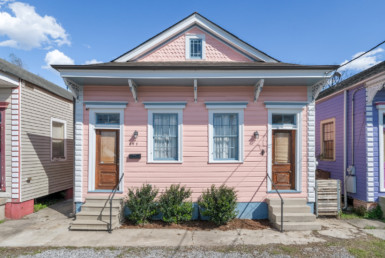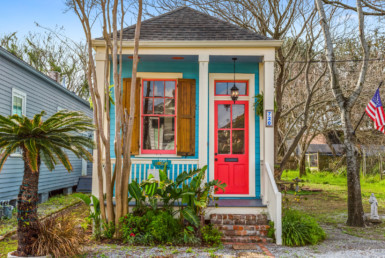Holy Cross

The Inner Harbor Navigation Canal, or Industrial Canal, is a narrow boundary, but it effectively separates urban Bywater from the relatively rural and settled Holy Cross Historic District. The cottages tucked alongside Sister Street near the canal levee sit on ample lots with modest rambling gardens. Many front porches have pets lolling about or children playing on them. Homes here tend to be owned, not rented, and it’s not unusual to find resident families going back three generations. A walkon the levee provides breathtaking views of New Orleans’ downtown and the curve of the river. The same walk brings you past a quick succession of New Orleans’ most famous buildings, including the “Steamboat Gothic” houses and the Holy CrossSchool, which gives the area its name.
The Holy Cross neighborhood sits on high ground near the river that was once part of several riverfront plantations. Bernard Marigny subdivided his considerable holdings here into Faubourg LaCourse around 1808. German and Irish immigrants and African Americans settled the region in sufficient numbers to call for the establishment of Catholic St. Maurice Parish. By 1900 what is now the Holy Cross neighborhood featured a number of small farms that provided produce, poultry and dairy products to New Orleans markets. Although Holy Cross itself is fairly high, the surrounding area was swampy until drainage improvements made in the 1910s helped dry out the land beyond St. Claude Avenue. During the same period, improved transportation made the neighborhood less remote from downtown New Orleans.
The Industrial Canal (1923) established a new term, the “Lower Ninth Ward,” for the district downriver of the canal. The desegregation of the school system, which began in 1960, prompted many white residents to leave Holy Cross and other urban neighborhoods. In 1965 Hurricane Betsy caused massive flooding and killed 70 people in the Ninth Ward, a disaster that prompted Holy Cross residents of all races to move elsewhere. By the 1970s, Holy Cross was a stable mixed neighborhood with about 60% African-American residents. New residents are drawn to Holy Cross by its affordable historic housing stock and its remarkable sense of community. Residents stress that it’s not a “hoity toity” place, but rather a neighborhood where people work for a living. “It’s just a regular Joe kind of lovely historic district,” says Holy Cross resident Pam Dashiell. Since the mid-1990s, Preservation Resource Center’s Rebuilding Together program has partnered with Holy Cross Neighborhood Association to fix up, paint and repair more than ninety neighborhood homes.
The best statement of present-day Holy Cross is the Delery Street Riverfront Playground, which residents built for themselves in an all-out volunteer effort in 1996. Hundreds of volunteers gathered materials, drew plans, engineered angles, and built one of the finest playgrounds in the city. Only steps away from the levee, it’s a safe place for the kids of Holy Cross to cut up with plenty of neighbors to watch for their safety.
Courtesy of the Preservation Resource Center of New Orleans.









